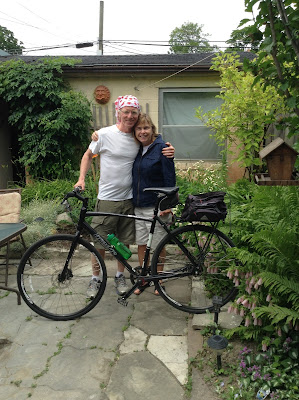The idea of cycling from Amsterdam to Copenhagen came to me in Toronto one spring night as I was thinking about how my hometown could evolve into a place that encouraged active transport. It was coincidental that my friend, Erma, contacted me to see if I would be interested in doing the same route, except westbound from Vordingborg, Denmark to Haarlem, west of Amsterdam. And so it was that I quickly bought a KLM ticket to Schiphol Airport. Packing as light as I could, I bid farewell to my partner, Cathy, seen here in our backyard with my Brodie commuter bike.
 |
Erma collected me from the airport early in the morning of June 24th. We cycled through her hometown of Haarlem, to and from her partner’s office. It became clear that the Dutch value bikes. There are separate traffic signal lights for bicycles and the density of bikes is impressive. From school children to grandparents, everyone seems to have and use a bike. Heaven.
The red brick path indicates for bikes only. Bike parking is generous and we both rode Kogas (Koga is a Dutch make) to a variety of destinations in Haarlem: Wouter’s office, a grocery store, a bike shop, the Apple Store, a supermarket. It is easy, convenient, and efficient to move about town this way.
In the afternoon, we rode to the train station on our bikes and took a train from Haarlem to Schiphol in a train car that is designed to accommodate bikes The flight from Amsterdam to Copenhagen required us to package the bikes in KLM boxes. This involved a simple, quick process of taking the pedals off, turning the handlebars, and taping the box.
At Copenhagen airport, there are train links that allow one to board the train with a bike. We did so and made our way to the town of Vordingborg, about 90 kilometres south of Copenhagen. Our hosts, Klaus and Helle, were awaiting our arrival. Showing great warmth and hospitality, they immediately fed us and ushered us to our rooms at a neighbour’s house (the neighbour was in Norway and kindly agreed to house us).








